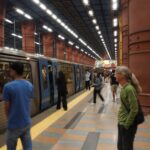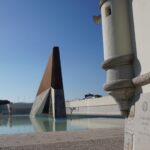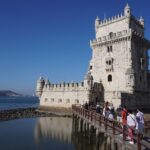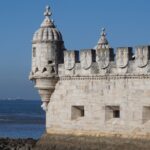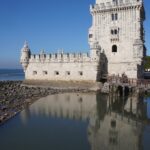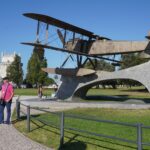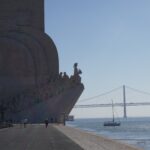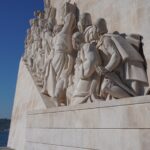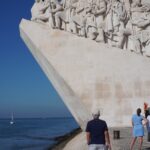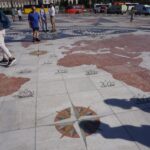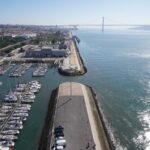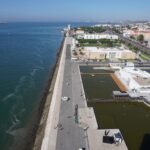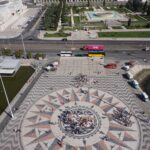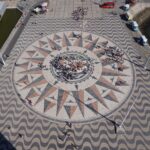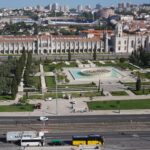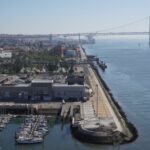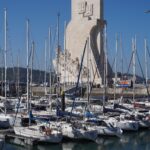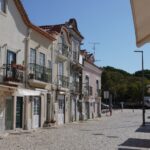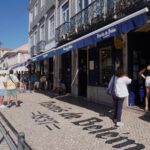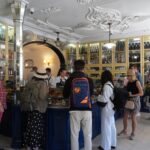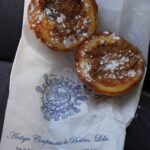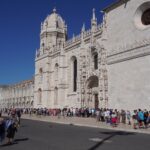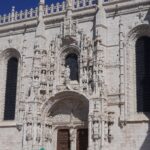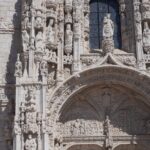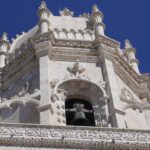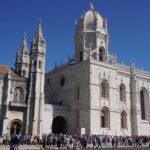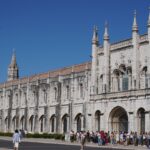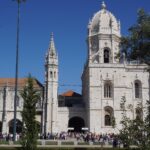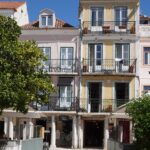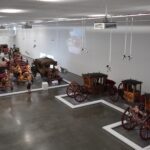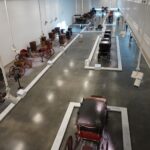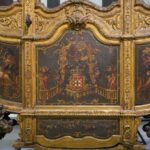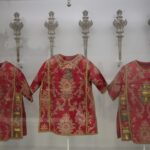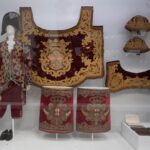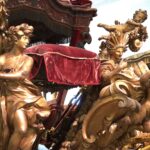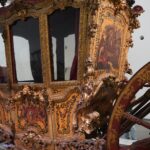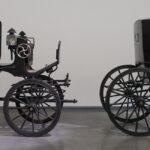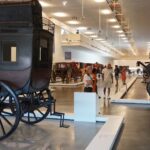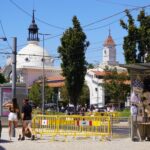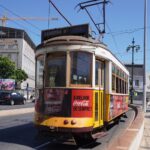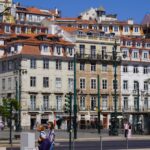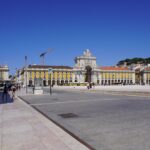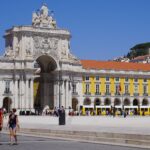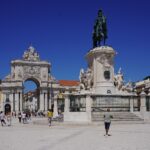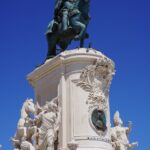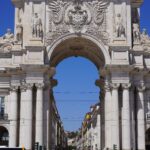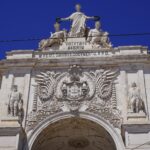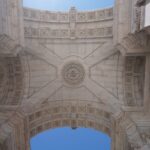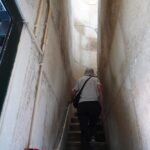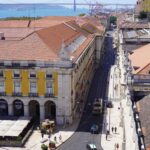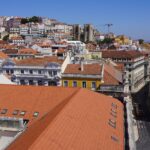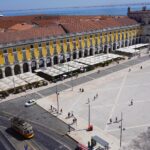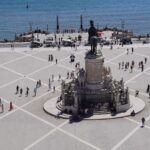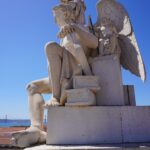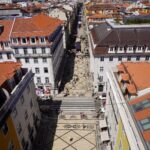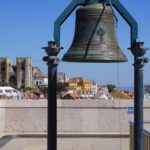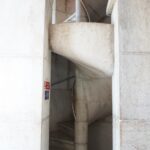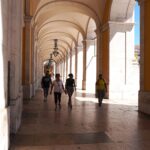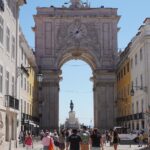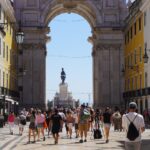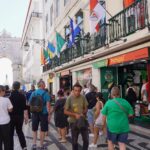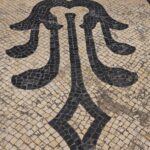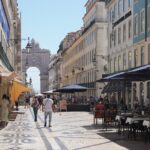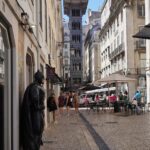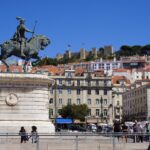Day one of exploring Lisbon.
We have discoverd there is a little shopping mall just around the corner at the back of our hotel. It not at all touristy and is used mainly by people living in the many surrounding apartments. There is a very good supermarket and a nice little cafe that sells very good coffee. I think we will pass through there every day. One euro forty for two black cafes.
From our hotel we took the red line underground metro and transferred to the green line underground metro to get down to the riverbank (Tagus River). From there we came back up to fresh air and took the surface train along the river to Belém where there are several notable historic sites to visit.
First up Belém Tower (Portuguese: Torre de Belém – literally Bethlehem Tower) built in the 16th century as a fortification to protect Lisbon from raiders coming in on the Tagus River. Officially it is the Tower of St Vincent. Originally it was on an island near the riverbank but the great earthquake of 1755 raised the river bed and altered the course of the river so now the island has merged with the land. It also served as a ceremonial gateway for sailors leaving and returning on the great voyages of discovery. It is built in the Portuguese Manueline style and is a UNESCO World Heritage Site. Manueline style is Late Gothic with a flamboyant use of decorative elements using elements like rope, chains, anchors, shells, seaweed, pearls, oak leaves, acorns, poppy capsules, thistles, corncobs etc, and celebrated Portugal’s status as a great maritime power.
Further along the Tagus River is the Monument to the Discoveries (Padrāo dos Descobrimentos). The original monument was built for the Portuguese World Fair in 1940 but the perishable materials were replaced by the present stone and concrete replica in 1960. The monument is a tribute to King Henry the Navigator and as well as he there are 32 statues of great men (there is only one woman – the queen) of the age of discovery including Vasco de Gama (discoverer of the sea route to India), Ferdinand Magellan (first to circumnavigate the globe) and Pedro Alvares Cabral (discoverer of Brazil). We took the lift and stairs inside the monument for panoramic views up and down the river. In the forecourt is a 50 metre diameter compass rose and a part map of the world. Part of Australia, New Zealand and the Pacific is missing.
From there we went over the road to the Jerónimos Monastery (Mosteiro dos Jerónomos), a former monastery of the Order of St Jerome. It is also in the Portuguese Manueline style, built in the sixteenth century and is a UNESCO World Heritage Site. It took a hundred years to build and was financed with a 5% tax on commerce with Africa and the Orient. King Manuel 1 selected the order of the monks and their role was to pray for his eternal soul and to provide spiritual assistance to the sailors who set off to discover new lands all around the world. This they did for 4 centuries until 1833 when the order was dissolved and the monastery was abandoned. We were keen to go into the monastery and its cloister but there was an enormous line with a wait time of 2 hours to enter. We have seen many monasteries and cloisters in Spain and will see more when we start our Camino so decided not to get baked standing out in the hot sun.
Next stop was the Pastéis de Belém bakery where they sell the original Pasta de Nata, a Portuguese egg custard tart pastry with crispy pastry crust and rich custard filling dusted with cinnamon. The following is the history of the tart from this bakery:
At the beginning of the 19th century, in Belém, next to the Jerónimos Monastery, there was a sugar cane refinery associated with a small place of varied commerce. As a consequence of the Liberal Revolution that occurred in 1820, all the convents and monasteries in Portugal were closed in 1834, expelling the clergy and workers.
In an attempt to survive, someone from the Monastery puts some sweet pastries on sale in that shop, quickly named “Pastéis de Belém”.
At the time, the Belém area was far from the city of Lisbon and the route was provided by steamboats. However, the imposing Jerónimos Monastery and the Belém Tower attracted visitors who soon became accustomed to tasting the delicious pastries that originated in the Monastery.
In 1837, the production of “Pastéis de Belém” began in facilities attached to the refinery, according to the ancient “secret recipe” that originated in the Monastery. It was passed down and known exclusively by the master pastry chefs who made them by hand in the “Oficina do Segredo”. This recipe has remained the same to this day.
In fact, the only true “Pastéis de Belém” factory manages, through a careful selection of ingredients, to provide today the taste of ancient Portuguese sweets.
Only this bakery can call the tarts Pastéis de Belém, all other bakeries call them Pasta de Nata. We bought some, freshly baked and warm, and ate them in a nearby park. Very yummy. We have bought them from two places back home in Wellington but they were not nearly as yummy as these.
Then what was probably the highlight of the day. We came across the National Coach Museum (Meseu Nacional dos Coches). This is one of the finest collections of historical coaches in the world. The original museum was created in 1905 by Queen Amelia to house an extensive collection of carriages belonging to the Portuguese royal family and nobility. The collection gives a full picture of the development of carriages from the late 16th through the 19th centuries, with carriages made in Italy, Portugal, France, Spain, Austria and England. The oldest carriage was from 1619. At the museum we also have a very nice lunch of lentil soup and toasta de queso y jamon.
From the elaborate baroque decoration of gilded carriages we caught a much more banal train to the Praço do Comércio, a huge square facing the river. The original buildings of this square were destroyed in the 1755 earthquake and subsequent tsunami and fire. After the earthquake the square was completely remodelled and rebuilt and housed all the government bureaux regulating customs and port activity. There is a huge triumphal central arch called the Arco da Rua Augusta which has a clock and is crowned with statues of Glory, Ingenuity and Valour. We climbed the tiny stone spiral stair to the top for views out over the square and river and inland up the Rua Augusta. From the square we walked Rua Augusta, Lisbon’s main pedestrian street that links Praço do Comércio with another important square, Rossio Square. It is a lively street full of cafes, music, performers, shops and of course the usual beggars and drug pushers.
From Rossio Square we went underground again to get back to the hotel. It was pretty warm today, 28 degrees, no cloud and no wind. We are still suffering from jet lag and were pretty zonked by the end of the day. I am getting to really like Lisbon and there is so much more to explore.
- First coffee in Lisbon
- Olaias Metro Station
- Olaias Metro Station
- Monumento dos Combatentes do Ultramar
- Monumento dos Combatentes do Ultramar
- Torre de Belem
- Torre de Belem
- Torre de Belem
- Torre de Belem
- Padrao dos Descobrimentos and Porta 25 da Abril
- Padrao dos Descobrimentos
- Padrao dos Descobrimentos
- Padrao dos Descobrimentos
- Padrao dos Descobrimentos
- Padrao dos Descobrimentos
- Compass, Padrao dos Descobrimentos
- Padrao dos Descobrimentos
- Porta 25 da Abril bridge over Rio Tejo
- Terre de Belem in distance fro top of Padrao dos Descobrimentos
- Compass and Jeronimos Moanastery
- Compass from top of Padrao dos Descobrimentos
- Jeronimos Moanastery from top of Padrao dos Descobrimentos
- Porta 25 da Abril from top of Padrao dos Descobrimentos
- Padrao dos Descobrimentos
- Typical street and housing, Belm, Lisbon
- Pasteis de Belem bakery
- Pasteis de Belem since 1837
- Pasteis de Belem
- Pasteis de Belem
- Pasteis de Belem
- Jeronimos Monastery
- Jeronimos Monastery
- Jeronimos Monastery
- Jeronimos Monastery
- Jeronimos Monastery
- Jeronimos Monastery
- Jeronimos Monastery
- Jeronimos Monastery
- Jeronimos Monastery
- Museu Nacional dos Coches
- Museu Nacional dos Coches
- Museu Nacional dos Coches
- Museu Nacional dos Coches
- Museu Nacional dos Coches
- Museu Nacional dos Coches
- Museu Nacional dos Coches
- Museu Nacional dos Coches
- Museu Nacional dos Coches
- Museu Nacional dos Coches
- Museu Nacional dos Coches
- Museu Nacional dos Coches
- Museu Nacional dos Coches
- Museu Nacional dos Coches
- Museu Nacional dos Coches
- Museu Nacional dos Coches
- Museu Nacional dos Coches
- Museu Nacional dos Coches
- Museu Nacional dos Coches
- Museu Nacional dos Coches
- Lunch of lentil soupa and toasta de queso y jamon
- Suburban train Lisbon
- Praco do Comercio
- Praco do Comercio
- Praco do Comercio
- Arc Rua Augusta
- Arc Rua Augusta
- Arc Rua Augusta
- Stair Arc Rua Augusta
- Praco do Comercio
- View from top of Arc Rua Augusta
- View from top of Arc Rua Augusta
- Praco do Comercio from top of Arc Rua Augusta
- Angel from on top of Arc Rua Augusta
- Rua Augusta from top of Arc Rua Augusta
- Trams and taxis from top of Arc Rua Augusta
- The bell atop Arc Rua Augusta
- Stone spiral stair to top of Arc Rua Augusta
- Colonnade Pracao do Commercio
- Arc Rua Augusta fro Rua Augusta
- Arc Rua Augusta fro Rua Augusta
- Rua Augusta
- Rua Augusta side street
- Rua Augusta
- Rua Augusta
- Arc Rua Augusta fro Rua Augusta
- Castelo de Sao Jorge from Praco de Figuera with Estatua Equestre de Dom Joao 1



